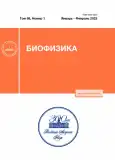Numerical modeling of pre-spawning and spawning migrations of the representative of the family hexagrammidae: the case of the arabesque greenling
- Authors: Chetirbotsky A.N1, Vdovin A.N2, Chetirbotsky V.A3
-
Affiliations:
- Far East Geological Institute, Far Eastern Branch of the Russian Academy of Sciences
- Pacific Branch of Research Institute of Fishery and Oceanography (“TINRO”)
- Lomonosov Moscow State University
- Issue: Vol 68, No 1 (2023)
- Pages: 134-141
- Section: Articles
- URL: https://journals.rcsi.science/0006-3029/article/view/144413
- DOI: https://doi.org/10.31857/S0006302923010155
- EDN: https://elibrary.ru/OBCFQP
- ID: 144413
Cite item
Full Text
Abstract
About the authors
A. N Chetirbotsky
Far East Geological Institute, Far Eastern Branch of the Russian Academy of Sciences
Email: chetyrbotsky@yandex.ru
Vladivostok, Russia
A. N Vdovin
Pacific Branch of Research Institute of Fishery and Oceanography (“TINRO”)Vladivostok, Russia
V. A Chetirbotsky
Lomonosov Moscow State UniversityMoscow, Russia
References
- В. В. Абрамов, Зоологич. журн., 32 (6), 1198 (1953).
- С. И. Павлов, Изв. Самарского науч. центра РАН, 11 (1), 34 (2009).
- A. Toleuchanov, M. Panfilov, and A. Karatauev, in Communications in Computer and Information Science. Mathematical Modeling in Technological Processes (Springer, 2015), Vol. 549, pp. 177-189.
- Ю. Н. Тютюнов, А. Д. Загpебнева, Ф. А. Cуpков и А. И. Азовcкий, Биофизика, 54, (3), 508 (2009).
- N. Takajoshi, Res. Popul. Ecd., 35 (1), 45 (1993).
- В. Н. Говорухин, А. Б. Моргулис и Ю. В. Тютюнов, Докл. РАН, 372 (6), 730 (2000).
- E. F. Keller and L. A. Segel, J. Theor. Biol., 30, 225 (1971).
- А. В. Никитина, Изв. ЮФУ. Технические науки, № 7 (96), 173 (2009).
- Y. V. Tyutyunova, L. I. Titovab, and I. N. Senina, Ecol. Complexity 31, 170 (2017).
- В. Н. Говорухин и А. Д. Загребнева, Компьютерные исследования и моделирование, 12 (4), 831 (2020).
- А. Б. Моргулис и К. К. Ильин, Вестн. ВГУ. Сер. Физика. Математика, № 2, 114 (2019).
- А. Б. Моргулис, Вестн. ЮУрГУ. Сер. "Математика. Механика. Физика", 11 (3), 28 (2019).
- В. Н. Гомелюк, Вопросы ихтиологии, 27 (6), 991 (1987).
- R. De Graaf and P. Dam, in Salish Sea Ecosystem Conf. (2014) p. 6. https://cedar.wwu.edu/ssec/2014ssec/Day1/6.
- W. E. Ricker, Computation and Interpretation of Biological Statistics of Fish Populations. Bull. 191 (Ottawa, 1975).
- А. Н. Колмогоров, в сб. Теория вероятностей и математическая статистика (Наука, М., 1986).
- А. Н. Вдовин, Изв. ТИНРО, 123, 16 (1998).
- M. D. Robarts and J. F. Piatt, J. Fish Biol., 54 (5), 1050 (2005).
- А. Н. Вдовин и А. Н. Четырбоцкий, Труды ВНИРО, 170, 26 (2018).
Supplementary files










